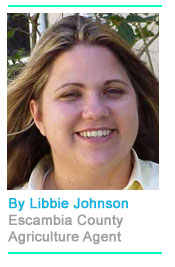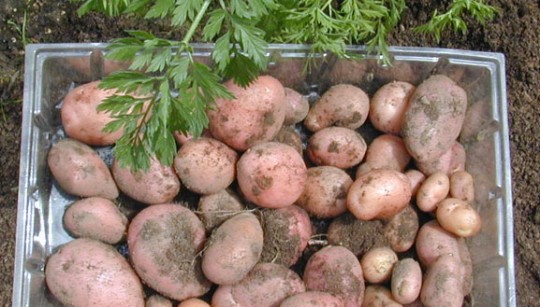Yes, You Can Grow Potatoes In North Escambia
January 8, 2011
These cold winter days make gardeners yearn for the warmth of April to be able to get their vegetable garden started, but they needn’t wait so long. Late January through February are ideal times for establishing some potatoes in the garden. When you are eating YOUR home-grown, fresh potatoes in May, you won’t even think of those the day you braved a cold, brisk wind and drizzly skies to get your potatoes planted.
For those not familiar with growing potatoes, you don’t plant the typical seed to get more of the wonderful vegetable. What growers call “seed” is actually a portion cut from a potato tuber that has an active growing point called the “eye”. Many gardeners plant seed potatoes that they cut themselves from potatoes purchased at grocery stores, but it is better to purchase seed potatoes that have been certified. Certification insures that the seed tubers are free of disease. You can usually purchase seed at farm and garden supply stores in our area, and you can usually order seed. If you are unsure of where you can buy the seed, call the Extension office.
 Before you plant any new crop, a soil test should be taken to determine soil fertility. Based on University of Florida fertilizer recommendations about 0.75 lbs of nitrogen(N) and about 0.5 lbs of potassium(K) are required per 100 ft of row at planting. This is roughly equivalent to 7.5 lb of a 10-0-10 complete fertilizer at each application. The remaining nitrogen and potassium fertilizer (0.75 lb N and 0.5 lbs K per 100 ft of row) should be placed in a band about four to six inches to either side of the plant approximately three to four weeks after planting. The fertilizer should be buried about two inches deep.
Before you plant any new crop, a soil test should be taken to determine soil fertility. Based on University of Florida fertilizer recommendations about 0.75 lbs of nitrogen(N) and about 0.5 lbs of potassium(K) are required per 100 ft of row at planting. This is roughly equivalent to 7.5 lb of a 10-0-10 complete fertilizer at each application. The remaining nitrogen and potassium fertilizer (0.75 lb N and 0.5 lbs K per 100 ft of row) should be placed in a band about four to six inches to either side of the plant approximately three to four weeks after planting. The fertilizer should be buried about two inches deep.
Mark the day you plant your seeds on the calendar. You will need to keep track of the age of your young potatoes. Plants should be spaced at about 6-8” within the row with at least 36” between rows. Seed pieces should be planted 4” below the soil surface. Seed pieces should be planted with the cut side down and eyes (or sprouts) facing up. Hilling is the act of adding soil to the top of the potato row. Since the seed piece was only planted 4” below the soil surface, there is the possibility that new potatoes will push up above the soil surface. Add about two or three inches of additional soil on the potato row when the sprout emerges from the soil (the sprout generally emerges around ten days to two weeks after planting). Soil can be moved from the furrows between rows and used for hilling.
Once you have your potatoes up and growing, you should see gradual growth of the vines. If we continue to have very cold temperatures, you might have to provide frost/freeze protection for the plants. Plants that are smaller than four to six inches can be covered with more soil if freezing temperatures are forecast. You can also cover them with fabric. Some people loosely mound hay over young plants and move the hay to the furrow when temperatures improve.
Should you start to see distortions in the leaves (from an insect, animal, or disease), don’t hesitate to contact your Escambia Co. Extension office. We can help you determine the cause of the problems and often provide a solution.
Potatoes that grow well here usually mature and ready for harvest 80-115 days after planting. Home gardeners who will be consuming their potatoes within a month or two can dig up their potatoes when they are ready, being careful to limit damage to the tuber when using tools. Most people don’t grow enough potatoes to be concerned with storing them for long periods of time, but if you do, please contact the Escambia Co. Extension office to learn more about how to keep potato tubers.
For more information about growing potatoes in the Home Garden, please visit http://edis.ifas.ufl.edu/pdffiles/HS/HS18300.pdf As always, you can contact the Escambia Co. Extension office at (850) 475-5230.
Comments
5 Responses to “Yes, You Can Grow Potatoes In North Escambia”




can I put down a layer of seaweed then put my seed taters on top and cover all with dirt? I would like to do this this Feb. Thanks
Harvested potatoes were often ‘bedded’ in a shallow hole maybe 2 ft deep and 6 or 8 ft in diameter. The hole needed to be on the side of a steep hill so it could stay well drained. line the hole with pine straw and layer of taters. repeat ’til hole was almost full and cover with galvanized roofing tin, an old car hood or whatever. Watch for rattle snakes when removing taters!
Daddy, Granddaddy and uncles planted “tater draws” from sweet potatoes.
A few healthy taters were set in moist soil or just plain water and allowed to ’sprout’ new green growth on top. These draws were cut off with a small amount of potatoe and planted. Seeds, the eyes on the taters were also planted from Arsh (Irish) potatoes. Northwest Fl and into Covington County Al.
Libbie Johnson ROCKS !!!
I’ll be planting potatoes, but I use a potato cage. Just have to water a little more, but dump it over on a tarp and you have your whole harvest there for you.